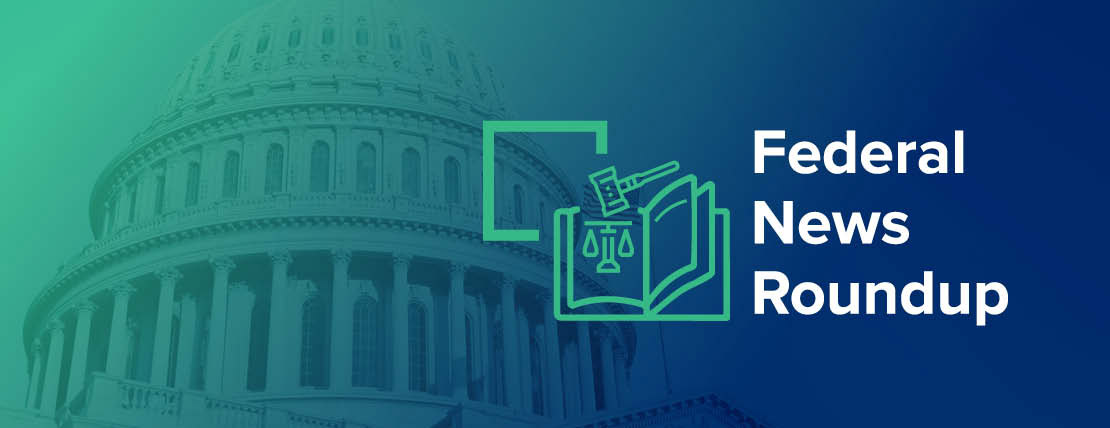- President Instructs Agencies to Expedite Repeal of Regulations
- DOL Gets 60-Day Delay to Ponder Legal Steps for Fiduciary Rule
- Trade Association Asks Attorney General to Pull NLRB Decisions
- Wilcox Requests that Supreme Court Not Rush Ruling
- Legislation Aims to Protect Retirement Savings in Chapter 11 Cases
- Bill Calls for OSHA to Create Health Worker Protection Rule
President Instructs Agencies to Expedite Repeal of Regulations
U.S. President Donald Trump on April 9 formally instructed federal government agencies — and with the assistance of Department of Government Efficiency (DOGE) teams assigned to those agencies — to repeal existing regulations that are inconsistent with his administration’s priorities ... and do so without providing advance notice or going through traditional procedures or channels.
The orders, outlined in a memorandum to agency heads as well as an ancillary fact sheet, speeds up the Trump administration’s stated efforts to reduce federal bureaucracy and complexity. However, by seeking to sidestep the typical process of notice, commentary period, etc., legal challenges are likely from labor unions, civil rights advocates and other entities.
In his memo, Trump categorized his new directives as the next step of Executive Order 14219 (“Ensuring Lawful Governance and Implementing the President’s ‘Department of Government Efficiency’ Deregulatory Initiative”), which on Feb. 19 mandated that executive department and agency heads “identify certain categories of unlawful and potentially unlawful regulations within 60 days and begin plans to repeal them.”
Trump’s new documents assert 10 recent Supreme Court rulings give his administration and its installed agency leaders the right to circumvent precedent processes, “where doing so is consistent with the ‘good cause’ exception in the Administrative Procedure Act.”
The memo stated, “That exception allows agencies to dispense with notice-and-comment rulemaking when that process would be ‘impracticable, unnecessary or contrary to the public interest.’ … [Standard] notice-and-comment proceedings are ‘unnecessary’ where repeal is required as a matter of law to ensure consistency with a ruling of the United States Supreme Court.”
The president’s memo makes the case that the Supreme Court’s 2024 Loper Bright decision applies retroactively, even though the court’s majority held in its opinion document that the decision is forward-looking (the term “going forward” is found on Page 80).
Law website JD Supra may have been best summed up the magnitude of this directive, categorizing it as “an aggressive push toward deregulation across all executive agencies,” and explaining, “The implications … cannot be overstated. Since 1976, federal agencies have published nearly 222,000 rules, totaling over 1 million pages of enacted rules in the Federal Register. Since 2000, federal agencies have published just shy of 612,000 notices of proposed rules (approximately 1.4 million additional pages published), and the Federal Register has published over 771,000 documents related to these proposed and enacted rules. All told, federal agencies have published nearly 3.3 million pages of rules, regulations, comments, etc., since 1976.”
DOL Gets 60-Day Delay to Ponder Legal Steps for Fiduciary Rule
On Tuesday, April 15, the U.S. Fifth Circuit Court of Appeals granted a request by the Department of Labor (DOL) for an additional 60 days to mull next steps in two court cases challenging its 2024 Retirement Security Rule.
Circuit Judge Catharina Haynes formally approved the DOL’s unopposed motion in a four-page court order. The agency had requested the delay to get the new presidential administration and DOL leadership (including recently confirmed Secretary of Labor Lori Chavez-DeRemer) up to speed on the issues presented by the litigation. The DOL rule in question was finalized during the Joe Biden administration by previous secretary Julie Su.
The DOL now has until June 16 to reply to appeals in the two cases (which now have been consolidated):
- American Council of Life Insurers, et al. v. U.S. Department of Labor, et al. (American Council of Life Insurers)
- Federation of Americans for Consumer Choice Inc., et al. v. U.S. Department of Labor, et al. (Federal of American for Consumer Choice)
In American Council of Life Insurers, the U.S. District Court for the Northern District of Texas sided with the plaintiff on July 26, 2024, putting a national stay on the rule. One day later, in Federal of American for Consumer Choice, the U.S. District Court for the Eastern District of Texas also granted a stay.
Both lawsuits sought to block the rule, which expanded the definition of an investment advice fiduciary under the Employee Retirement Income Security Act (ERISA), providing requirements when such entities advise plan participants on retirement plan design, annuity sales and individual retirement account rollovers.
The updated definition clarifies HR professionals who conduct typical retirement plan work are not acting as fiduciaries. However, these and other corporate professionals may be specified as a fiduciary when they, in certain cases, provide financial advice on even a one-time basis.
Trade Association Asks Attorney General to Pull NLRB Decisions
The Coalition for a Democratic Workplace (CDW), a trade association of several hundred employers and employer associations (including the U.S. Chamber of Commerce and the National Association of Manufacturers), recently sent a letter to Attorney General Pam Bondi asking her to invalidate more than a dozen major decisions issued by the National Labor Relations Board (NLRB) during the Biden administration. These decisions cover issues such as which workers have the right to form and join a union and what remedies are available to workers who are fired in retaliation for exercising their workplace rights.
In its request, the CDW cited the Supreme Court decision in Skidmore v. Swift & Co., which “allows a federal court to yield to a federal agency’s interpretation of a statute administered by the agency according to that agency’s ability to demonstrate ‘persuasive reasoning.’”
The association wrote, “These legal positions [in the cited NLRB decisions] are unconstitutional, inconsistent with governing statutes, and/or otherwise poorly reasoned and unlikely to persuade a court under Skidmore [standards].”
It went on to question the role of agencies such as the NLRB, stating, “An NLRB adjudication is merely an enforcement decision by an executive agency. Though it acts in some ways like a court, the board is not exercising judicial power. It is making an enforcement decision that is then subject to review by an actual Article III court. ... Any legal interpretations the board reaches and applies in that decision, therefore, are simply enforcement positions that, like all executive branch enforcement policies, may be changed at any time.”
The Economic Policy Institute, a Washington, D.C.-based nonprofit think tank, questioned the logic in the CDW’s request, stating in a blog post, “This dangerous suggestion is clearly unlawful in numerous respects. First, it completely undermines Congress’ directive that the NLRB functions as an independent agency, with labor disputes adjudicated by a panel of experts insulated from political influence. Second, if the agency did comply with this directive and revert to the law as it existed prior to the targeted decisions, any decisions following this earlier law would clearly run afoul of the Administrative Procedure Act, as the agency’s changed course would have no statutory explanation at all — the exact opposite of the ‘reasoned decision-making’ that the APA requires.”
Wilcox Requests that Supreme Court Not Rush Ruling
Former NLRB member Gwynne Wilcox on Tuesday, April 15, implored the U.S. Supreme Court to reject President Trump’s bid to keep her unemployed and take the necessary time to determine whether he has the power to remove members of independent federal agencies without cause.
Wilcox, who was fired by Trump in January, sent a 44-page letter to the high court, via her legal team, in response to Chief Justice John Roberts’ April 9 stay of an April 7 appellate court decision. The U.S. Court of Appeals for the District of Columbia Circuit, in a 7-4 decision, had ruled that Trump’s firings of Wilcox and Merit Systems Protection Board (MSPB) member Cathy Harris were unlawful. That ruling enabled Wilcox and Harris to return to their board posts, until Roberts paused that, pending full Supreme Court review.
At play is the continued viability of the Supreme Court’s 1935 Humphrey’s Executor precedent, which made it illegal to fire workers from independent government agencies without cause. Trump and his legal team have built the case that such shields are an unconstitutional limit on a president’s power.
“For 90 years, this Court has allowed this law to stand. And for 90 years, the law has stood unchallenged by 14 presidential administrations,” stated Wilcox through her general counsel’s letter. “No real-world harm will come from allowing the ordinary appellate process to unfold over a few more months. The Court should, therefore, deny the government’s motion in all respects. But, at a minimum, if the Court is inclined to grant certiorari [an order by which a higher court reviews a decision of a lower court] before judgment, it should set the case for argument at the start of the new term, not in May, to allow for adversarial presentation and careful deliberation commensurate with the gravity of the issue.”
Supreme Court terms begin in October and usually run until late June.
Legislation Aims to Protect Retirement Savings in Chapter 11 Cases
Senators Dick Durbin (D-Illinois) and Josh Hawley (R-Missouri) on April 9 reintroduced the “Protecting Employees and Retirees in Business Bankruptcies Act,” legislation that was previously introduced in 2024.
The bipartisan bill seeks to counter an increase in company bankruptcies by modifying Chapter 11 bankruptcy standards to place restrictions on excessive compensation for executives and allow employees to retain more of their wages, benefits and retirement savings in cases of corporate failure.
“Currently, the law fails to adequately look out for employees during bankruptcy proceedings,” Hawley said in a statement. The bill “would put workers first, granting employee claims higher priority and placing restrictions on golden parachutes for executives. ... Employees shouldn’t be the ones left holding the bag when companies go under. Rather than giving precedence to the desires of predatory creditors, we should prioritize workers and protect the compensation they’ve earned through years of hard work.”
Bill Calls for OSHA to Create Health Worker Protection Rule
Sen. Tammy Baldwin (D-Wisconsin) and Rep. Joe Courtney (D-Connecticut) recently introduced “Prevention of Workplace Violence in Health Care and Social Assistance,” legislation that would require healthcare employers to write and implement a workplace violence prevention plan.
The Occupational Safety and Health Administration (OSHA) has studied workplace violence in the healthcare industry for nearly a decade, and said last year it would issue a proposed rule. The Baldwin-Courtney bill would mandate that the agency create that standard, essentially writing the requirements into law.
Healthcare worker organizations, including the National Nurses United, back the legislation, calling it a solution to a “preventable” problem.
However, if passed, healthcare employers could take on hefty costs. OSHA estimates compliance would annually cost $1.22 billion, in aggregate, for the more than 300,000 covered entities (hospitals, home health providers, emergency medical technicians, and residential and behavioral care facilities).
Editor’s Note: Additional Content
For more information and resources related to this article, see the pages below, which offer quick access to all WorldatWork content on these topics:







